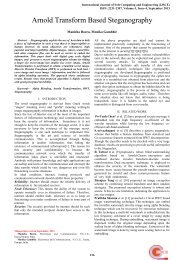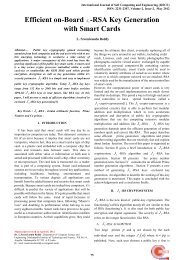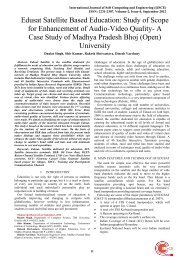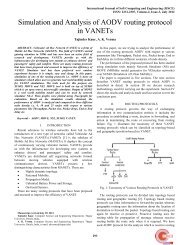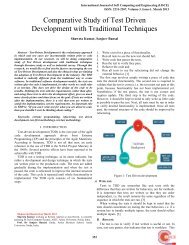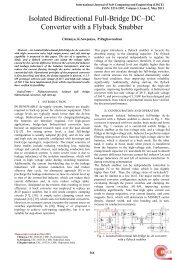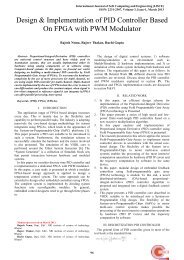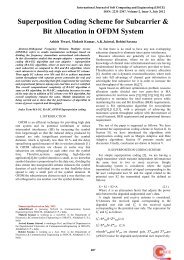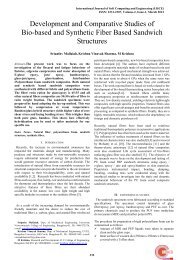InGaAs/GaAs HEMT for High Frequency Applications - International ...
InGaAs/GaAs HEMT for High Frequency Applications - International ...
InGaAs/GaAs HEMT for High Frequency Applications - International ...
Create successful ePaper yourself
Turn your PDF publications into a flip-book with our unique Google optimized e-Paper software.
<strong>International</strong> Journal of Soft Computing and Engineering (IJSCE)<br />
ISSN: 2231-2307, Volume-3, Issue-1, March 2013<br />
<strong>In<strong>GaAs</strong></strong>/<strong>GaAs</strong> <strong>HEMT</strong> <strong>for</strong> <strong>High</strong> <strong>Frequency</strong><br />
<strong>Applications</strong><br />
N V Uma Reddy, M V Chaitanya Kumar<br />
Abstract -In the modern VLSI especially <strong>for</strong> high speed<br />
devices, where the conventional MOSFET technology is reaching<br />
its limitations due to various short channel effects and velocity<br />
saturation effects etc, hetero-junction FETs have shown great<br />
promise <strong>for</strong> high speed devices. Novel <strong>HEMT</strong> device using<br />
heterojunctions made of and on a<br />
substrate is designed and modeled using TCAD software. <strong>High</strong>ly<br />
doped deep source-drain implants are proposed <strong>for</strong> the design.<br />
The device simulations have demonstrated its utility towards high<br />
frequency applications in GHz range.<br />
Keywords- <strong>HEMT</strong>,<br />
I. INTRODUCTION<br />
Recent developments in satellite communications and<br />
broadband communications have led the microelectronics<br />
industry to develop and fabricate devices with increasing<br />
cut-off frequency. Heterojunction bipolar transistors show<br />
good cut-off frequencies but are poor in noise per<strong>for</strong>mance<br />
[1]. Unipolar devices, mainly high-electron mobility<br />
transistors (<strong>HEMT</strong>s) provide high frequency per<strong>for</strong>mance at<br />
low noise levels. This property is the result of the higher<br />
electron mobilities of the materials involved, higher<br />
saturation velocities and higher electron densities [2].<br />
Improvements in device per<strong>for</strong>mance can be obtained by<br />
reducing the gate length. However, short channel effects<br />
limit the microwave per<strong>for</strong>mance of the device due to<br />
which, the tradeoff between the layer structure and the<br />
device geometry should be optimally designed using<br />
computer simulations, to help reduce time and cost [2].<br />
Indium content in the devices provides them an improved<br />
RF per<strong>for</strong>mance, but higher Indium content leads to lower<br />
breakdown, kink effect. Parasitic source to drain(S/D)<br />
resistance also degrades the high frequency per<strong>for</strong>mance of<br />
the device. Hence a lower S/D resistance is desirable [3].<br />
In this paper, a novel channel <strong>HEMT</strong> with source<br />
drain regions of highly doped is presented. Induced<br />
strain in the channel is utilized <strong>for</strong> mobility improvement.<br />
<strong>High</strong>er S/D doping concentration reduces the series sourcedrain<br />
resistance.<br />
Manuscript received on March, 2013<br />
N V Uma Reddy, Electronics and Communication Engg. Research<br />
Scholar, VTU, Bangalore, Karnataka, India.<br />
Dr M V Chaitanya Kumar, Professor and Principal, BIT, Mangalore,<br />
Karnataka India.<br />
II.<br />
HETEROJUNCTIONS<br />
Hetero-junctions refer to the interface between two layers of<br />
dissimilar crystalline semiconductors [2], where the<br />
conventional MOSFET technology is reaching its<br />
limitations due to various short channel effects and velocity<br />
saturation effects etc, hetero-junction FETs have shown<br />
great promise <strong>for</strong> high speed devices. In contrast to the<br />
homo-junctions, hetero-junctions have materials with<br />
unequal band gaps (mostly semiconductors) and the<br />
device properties depend on the mismatch in the band gap of<br />
the materials. The band gap in the semiconductors<br />
can be engineered by varying the mole fraction of the<br />
constituents and hence the devices properties can also be<br />
tailored. A typical band diagram of a hetero-junction is<br />
shown in Figure 1.<br />
Figure 1 Band Diagram in Hetero-Junctions (where<br />
notations have their usual meanings)<br />
Hetero-junctions achieve high mobility and high electron<br />
concentration by concentrating the carriers into a region<br />
devoid of any ions. Hence the mobility degradation due to<br />
the ionized ion scattering is absent.<br />
The idea behind making a hetero-junction FET is to have<br />
a high band gap material followed by a low band gap<br />
material so as to <strong>for</strong>m a potential well(quantum well) (the<br />
notch as visible in the above figure). In conventional<br />
MOSFETs, the channel or a quantum well is <strong>for</strong>med at the<br />
interface between oxide (high band-gap) and bulk silicon<br />
(low band-gap).<br />
For a given doping level, as a result of discontinuity in the<br />
conduction band, band bending is more in the<br />
Heterojunction than in the homojunction. The larger band<br />
bending will result in the edge of conduction band in the<br />
neutral region being raised by . determines electron<br />
concentration in the quantum well. Further, Φ s , the potential<br />
barrier is higher in the Heterojunction than the<br />
homojunction by .<br />
16
<strong>In<strong>GaAs</strong></strong>/<strong>GaAs</strong> <strong>HEMT</strong> <strong>for</strong> <strong>High</strong> <strong>Frequency</strong> <strong>Applications</strong><br />
III.<br />
DEVICE SIMULATION<br />
Figure 2 shows the device structure <strong>for</strong> the simulated<br />
<strong>HEMT</strong> structure.<br />
layer <strong>for</strong>ms the active<br />
channel region and is separated from the substrate by<br />
. The device structure <strong>for</strong> simulation is<br />
obtained by simulating the fabrication steps as mentioned in<br />
the following section.<br />
while is the donor concentration in the barrier layer,<br />
is the Fermi level with respect to the conduction band edge<br />
in the channel layer, and Δ is the conduction band offset<br />
between the barrier and channel [5].<br />
The threshold voltage is given as [6]:<br />
…(3)<br />
<strong>for</strong> modulation doped structure.<br />
Transconductance, is defined as the change in the drain<br />
to source current divided by the change in the gate to source<br />
voltage at certain drain to source voltage [2]<br />
. …(4)<br />
It is the most important dc figure of merit in field effect<br />
transistors as it demonstrates the current modulation<br />
efficiency of the gate.<br />
was computed to be<br />
structure.<br />
<strong>for</strong> the proposed <strong>HEMT</strong><br />
Figure 2 <strong>HEMT</strong> Structure<br />
) and are grown on<br />
substrate using molecular beam epitaxy (MBE)<br />
process.where . Wet chemical MESA etching is<br />
used to isolate the active area of the device. Deep source and<br />
drain regions are realized with highly doped .<br />
To obtain source-drain contacts, gold is evaporated and then<br />
alloyed at using rapid thermal annealing. Gate metal<br />
contacts are deposited as Schottky gate metal using Gold<br />
lift-off. The device is passivated using deposited by<br />
plasma enhanced chemical vapor deposition.<br />
IV. ANALYTICAL DESCRIPTION OF OPERATION<br />
A. Analytical expression <strong>for</strong> 2DEG (two dimensional<br />
elecctron gas) density:<br />
The basic qualitatively description of <strong>HEMT</strong>’s operation is<br />
based on 1-dimensional charge control model at the<br />
direction perpendicular to the hetero-interface. The electric<br />
potential (band diagram) and charge distribution follows the<br />
Poisson’s equation and the electron wave function satisfy<br />
the Schrodinger’s equation [4]. Theoretically the potential<br />
and charge profile can be calculated by self-consistently<br />
solving the two equations. Based on the assumption that the<br />
charge depleted from the donor layer is accumulated in the<br />
2DEG, the Fermi level is constant across hetero-interface,<br />
and the interfacial potential at the channel can be<br />
approximated by a triangular well, the electron charge( )<br />
stored at the interface in a modulation doped structure is [5]<br />
V. DEVICE MODELING<br />
The <strong>HEMT</strong> device structure was modeled in TCAD<br />
software. Figure 3 shows the <strong>HEMT</strong> structure built using<br />
TCAD tool. After building the structure and assigning the<br />
material properties, device simulations were carried out.<br />
Figure 3 <strong>HEMT</strong> structure modeled in SILVACO<br />
Doping concentrations were extracted across different<br />
sections along the device. The doping profiles are<br />
summarized in figure 5 to 8.<br />
…(2)<br />
where is the dielectric constant of the barrier layer, q is<br />
electron static charge, d is sum of the thickness of undoped<br />
barrier and doped barrier , is the applied gate to<br />
source voltage, is the Schottky barrier height of the gate<br />
metal deposited on the barrier layer,<br />
Figure 4 Cut Sections<br />
17
Doping concentration contours near the junctions are<br />
extracted from the simulation and presented in figure 9.<br />
<strong>HEMT</strong> per<strong>for</strong>mance was simulated using TCAD and<br />
device was characterized through its ,<br />
current gain plots. Device transconductance, threshold<br />
voltage, unity gain frequency were extracted from the<br />
simulation results. Different results are presented in Section<br />
VI.<br />
<strong>International</strong> Journal of Soft Computing and Engineering (IJSCE)<br />
ISSN: 2231-2307, Volume-3, Issue-1, March 2013<br />
VI.<br />
RESULTS AND DISCUSSION<br />
Doping concentrations in the device across various<br />
cross-sections are shown in Figures 5 to 8. The cross<br />
sections are defined as in Figure 4. Figure 5 shows the<br />
doping concentration is high in the S/D<br />
regions. Figure 6 depicts the doping profile along<br />
section 2. It depicts the presence of a relatively high<br />
doped layer. Figure 7 demonstrates highly<br />
doped source/ drain regions with lightly doped channel<br />
layer. The simulation results confirm the high doping<br />
levels in the deep source drains to the order of<br />
. Figure 8 shows the doping profiles <strong>for</strong> the<br />
deep S/D and the substrates. The doping profile of S/D<br />
is of the order of whereas the substrate is<br />
intrinsic at higher depths.<br />
Band structure was extracted <strong>for</strong> the <strong>HEMT</strong> device and<br />
is shown in Figure 10. The presence of a quantum well<br />
type of structure can be observed. The figure shows the<br />
band offsets in the conduction band and the valence<br />
band between the<br />
Heterojunction. These band offsets give rise to the band<br />
bending and hence the confinement of the charge<br />
carriers.<br />
Total current density is plotted in Figure 11. The<br />
maximum current density is observed in the<br />
layer as expected and is around .<br />
Threshold voltage of the device can be obtained from<br />
the slope of the plot. From figure 12, the max<br />
slope of the plot occurs at . Hence the<br />
approximate threshold voltage <strong>for</strong> the device from the<br />
simulations is around which is near to the<br />
calculated value of .<br />
The plot in Figure 13 shows a nearly flat<br />
region at<br />
and above. The device is<br />
operating in the saturation in this region. The drain<br />
current practically is not changing in this region as a<br />
result of the bias and hence is fully controlled by<br />
the gate voltage only.<br />
Figure 14 shows the gate capacitance variation with the<br />
gate bias. It shows a typical curve like that of a<br />
MOSFET device with device operating in accumulation<br />
<strong>for</strong> and in inversion region <strong>for</strong> .<br />
The steep transition from accumulation to inversion or<br />
vice-versa shows that there are very few trapped<br />
impurities in the device.<br />
The AC analysis shows that the current gain is flat up to<br />
and has a unity gain frequency beyond<br />
and hence is usable <strong>for</strong> high frequency<br />
applications. <strong>High</strong> current gain of and<br />
transconductance gain of is obtained <strong>for</strong> the<br />
device.<br />
Figure 5 Net Doping across Section1<br />
Figure 6 Net Doping across Section 2<br />
Figure 7 Net Doping across Section 3<br />
Figure 8 Net Doping across Section 4<br />
18
<strong>In<strong>GaAs</strong></strong>/<strong>GaAs</strong> <strong>HEMT</strong> <strong>for</strong> <strong>High</strong> <strong>Frequency</strong> <strong>Applications</strong><br />
Figure 12 I d -V gs plot<br />
Figure 9 Depletion layers at Junctions<br />
Gold<br />
InAlAs<br />
<strong>In<strong>GaAs</strong></strong><br />
<strong>GaAs</strong><br />
Figure 13 I d -V ds plot<br />
Figure 10 Band structure <strong>for</strong> the <strong>HEMT</strong> device<br />
Figure 14 Gate Capacitances (V ds =0.5V)<br />
Figure 11Total Current Density<br />
Figure 15Current gain v/s <strong>Frequency</strong><br />
19
<strong>International</strong> Journal of Soft Computing and Engineering (IJSCE)<br />
ISSN: 2231-2307, Volume-3, Issue-1, March 2013<br />
Figure 16 Trans-conductance v/s frequency<br />
CONCLUSION<br />
A Heterojunction <strong>HEMT</strong> is designed and modeled using<br />
TCAD software and the device per<strong>for</strong>mance is simulated.<br />
The device shows high unity gain bandwidth of the order of<br />
which makes the device promising <strong>for</strong> use in high<br />
frequency applications. The device shows good output<br />
impedance as is evident from the plot. The device<br />
has shown a current gain of and a trans-conductance<br />
gain of .<br />
REFERENCES<br />
[1] D. H. Kim and J. A. Del Alamo, “30 nm E-mode InAs P<strong>HEMT</strong>s <strong>for</strong><br />
THz and future logic applications,” in IEDM Tech. Dig., Dec. 2008,<br />
pp. 719–722.<br />
[2] Ghandhi, S.K. “VLSI Fabrication Principles- Silicon and Gallium<br />
Arsenide”, Second Edition, John Wiley & Sons, New York (1994).<br />
[3] A. Leuther, R. Weber, M. Dammann, M. Schlechtweg, M. Mikulla,<br />
M. Walther, and G. Weimann, “Metamorphic 50 nm InAs-channel<br />
<strong>HEMT</strong>” in Proc. 17th Int. Conf. IPRM, May 2005, pp. 129–132.<br />
[4] William Liu. “Fundamentals of III-V Devices”. John Wiley & Sons,<br />
1999.<br />
[5] Kennedy D.P (1975). “The potential and electric field at the<br />
metallurgical boundary of an abrupt p-n semiconductor junction”.<br />
IEEE Trans. Electr. Dev. 22, 988-994.<br />
[6] W, Liu “Fundamentals of III-V devices”, John Wiley & Sons, New<br />
York (1999).<br />
[7] “ http://www.cleanroom.byu.edu/EW_ternary.phtml”<br />
[8] Adachi, S (1985, Aug) “<strong>GaAs</strong>, AlAs, and Al xGa 1-xAs: Material<br />
parameters <strong>for</strong> use in research and device applications.” J Appl Phys<br />
58, R1-R29<br />
Mrs. Umareddy N.V received her BE<br />
(Electronics) degree from Kuvempu University in<br />
1995 and M.Tech (Electronics) degree from<br />
Viveswaraya technological University Belgaum,<br />
India in 2004, Presently pursuing PhD in VTU,<br />
Bangalore, India.she has more than fifteen years of<br />
experience in teaching her area of interest include<br />
CMOS VLSI, HDL, CCN, AMS, presently she is<br />
Working as HOD, Professor in the Department of Electronics and<br />
Communication Engineering in AMC Engineering College, Bangalore.<br />
Dr. CHAITANYA KUMAR M V received his BE<br />
(Electronics) degree from University Visweswariah<br />
College of Engg INDIA in 1983, and ME<br />
(Microwave & Radar Engg) degree from the<br />
University of Roorkee, Roorkee, India (now IIT-R)<br />
in 1991 and the Ph.D. degree on (Electronics &<br />
Computer Engg.) from the University of Roorkee,<br />
Roorkee, India in 1994. He has more than 29 years of experience in<br />
Teaching, 20 years of Administrative Experience and 6 years of Research<br />
Experience. He has been a Member of The academic senate VTU,<br />
Belgaum during the year 2007 - 10, He is now the Principal and Professor<br />
in Bearys Institute of Technology, Innoli, Mangalore. His area of interests<br />
include Electromagnetic wave Absorbers, Microwave and Radar<br />
technology.<br />
20



